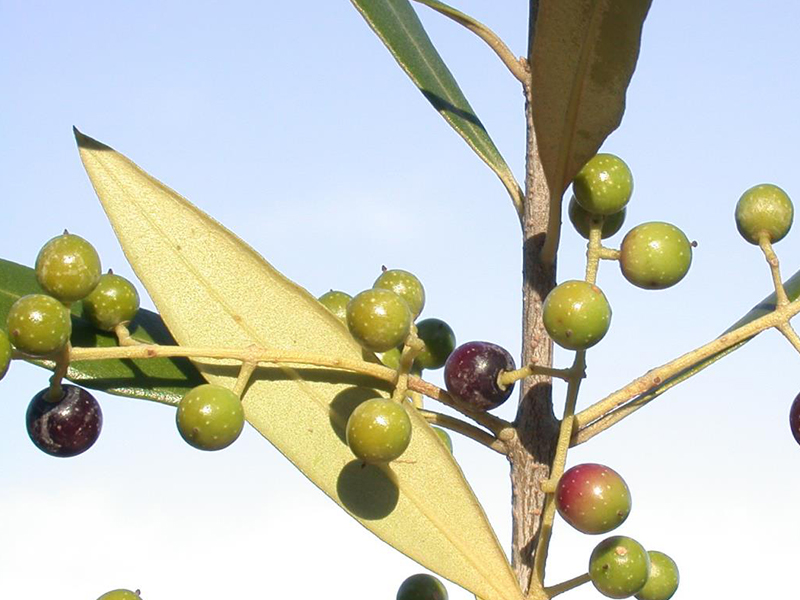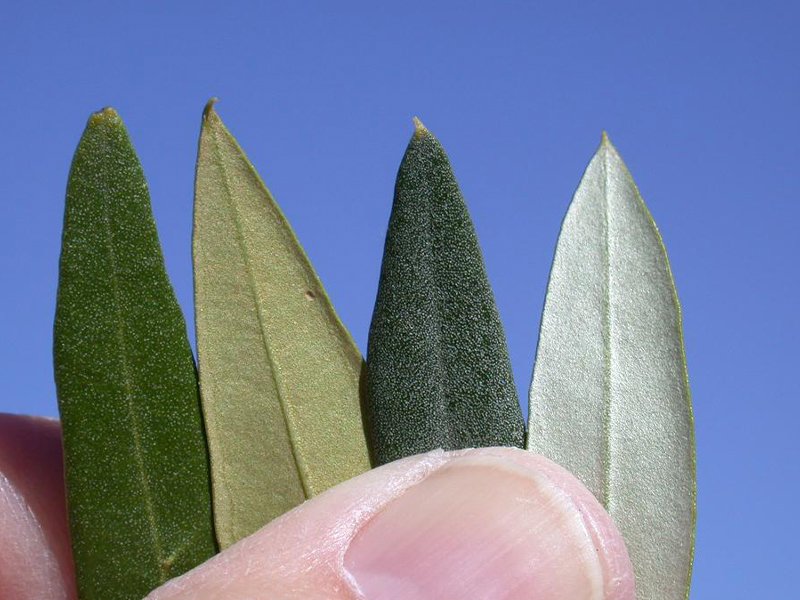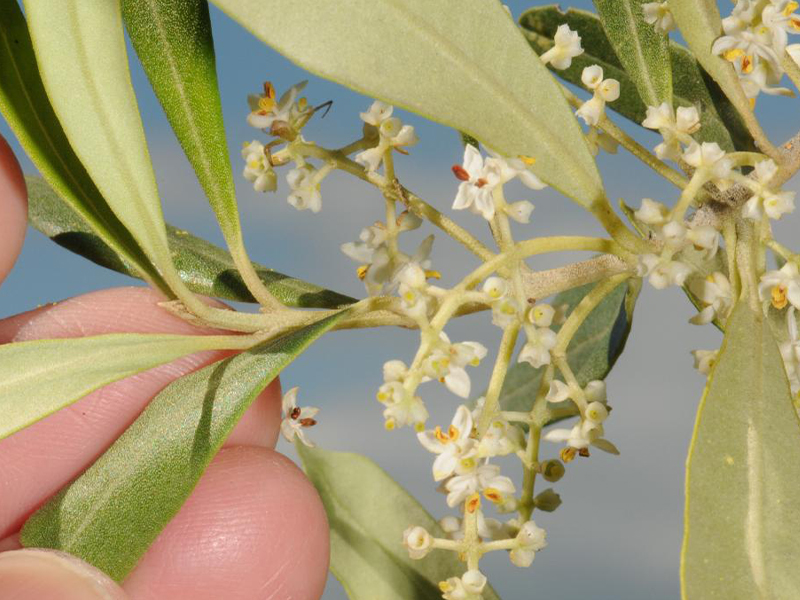Weeds
African Olive – Olea europaea subsp. cuspidata
African olive is a long-lived tree. It invades bushland and shades out native plants.
African olive (Olea europaea subsp. cuspidata) is regarded as a significant environmental weed in New South Wales and on Norfolk Island. It was recently also listed as a priority environmental weed in at least one Natural Resource Management region.
This plant should not be sold in parts of NSW
Common olive (Olea europaea subsp. europaea) is regarded as a significant environmental weed in South Australia, and as an environmental weed in Victoria, Western Australia, New South Wales, Queensland and the ACT. It was recently listed as a priority environmental weed in at least one Natural Resource Management region.
Profile
How does this weed affect you?
- invades bushland
- produces dense shade and suppresses native understory plants
- permanently changes plant diversity in bushland
- may also harbour diseases and pests of commercial olives
- fruit is not edible.
Appearance
African olive is a much-branched evergreen shrub or small tree with a dense canopy.
Leaves
- glossy grey-green on top
- green or yellow-brown underneath
- 6 — 10 cm long
- 10 — 25 mm wide
- often with a hooked tip
- opposite on the stem.
Flowers
- 2-4 mm diameter
- yellow-white to creamy white
- with 4 petals
- on a short stem.
Fruit
- 15-30 mm long
- 6-20 mm wide
- round with a sharp tip at the base
- green with white spots when unripe
- purple-black when ripe
- with one hard seed in the middle.
Seeds
- hard
- brown
- 10 -15 mm long
- oblong shape.
Stems
- silvery-green
- mostly upright
- smooth or slightly ribbed when younger
- covered in rough, light or dark grey bark when older.
African olive looks like several other olive trees.
- Common olive (Olea europa) has leaves that are silvery-grey underneath and with pointed tips
- Native mock olives (Notelaea venosa and Notelaea longifolia) have leaves which are much bigger and have a leathery texture. Notelaea longifolia has hairy leaves.
- Feral olive Olea europaea subsp. europaea is also a weed with similar impacts to African olive.
Where is it found?
African olive grows throughout NSW. The worst infestations are around southwest Sydney and the central Hunter Valley. It has naturalised along the whole of the western slopes from north to south.
In the 1800s it was introduced to Australia as a hedging plant and as root stock for edible olives. African olive first naturalised along coast between Milton and Lismore. It is a tropical wild olive that comes from eastern Africa.
What type of environment does it grow in?
African olive prefers warm temperate and semi-arid regions. It can grow in dense shade.
How does it spread?
By seed: Birds eat the fruit and spread the seed.
By plant parts: African olive produces suckers when trees are damaged.
More information
- PlantNET NSW FloraOnline, Olea europaea subsp. cuspidata. Royal Botanical Gardens and Domain Trust.
- Weed futures: Determining current and future weed threats in Australia, Olea europaea subsp. cuspidata. Macquarie University.
Control
Successful weed control requires follow up after the initial efforts. This means looking for and killing regrowth or new seedlings. Using a combination of control methods is usually more successful. Aim to control plants before they fruit.
Physical removal
Hand weeding – Pull out seedlings, removing all the roots.
Chemical control
Use the cut and paint method on established plants up to 10 cm diameter. Use stem injection for plants with a stem >10 cm diameter. African olive re-sprouts from the base if it is burnt or cut down. Re-spray new growth.
Similar natives that are not weeds
An introduced species, invasive or non-native species is a species living outside its native distributional range, but which has arrived there by human activity, either deliberate or accidental. These organisms have often been introduced to areas in which they are not native, usually without much regard to the harm that could result.
In many cases there are native plant species that resemble the introduced variety. If you like the look of the introduced species, why not consider an Australian native species with similar aesthetics instead. You will not only have a beautiful garden, you will also be doing something positive for the local flora and fauna.
African olive (Olea europaea subsp. cuspidata) can also be confused with other species including some native species (especially when not in fruit) including Australian olive (Olea paniculata), Northern olive (Chionanthus ramiflora) and the Mock olives (Notelaea spp.). These species can be distinguished by the following differences:
-
Common olive – Olea europa
Common olive also known as the Feral olive(Olea europaea ) This is not native and also considered an environmental weed in All states and territories of Australia. It has leaves with silvery-grey or greenish-brown hairy (i.e. pubescent) undersides. Its flowers are borne in branched clusters (i.e. panicles) and its fleshy fruit are relatively large (15-30 mm long)
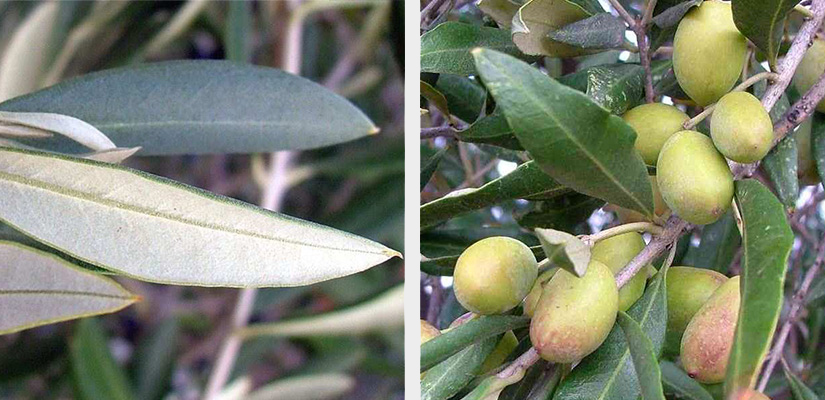
European olive (Olea europaea subsp. europaea) leaves, showing their silvery undersides and Immature fruit(Photo: Sheldon Navie)
-
Australian olive or Native Olive – Olea paniculata
The Australian olive – Olea paniculata is a native and has oppositely arranged leaves with paler green hairless (i.e. glabrous) undersides. Its flowers are borne in branched clusters (i.e. panicles) and its fleshy fruit are relatively small (about 10 mm long).

Leaves and fruit,Photograph by: Mark Marathon & Flowering branch Photograph by: Fagg M.
-
Northern olive – Chionanthus ramiflora
The northern olive (Chionanthus ramiflora) has oppositely arranged leaves with paler green hairless (i.e. glabrous) undersides. Its flowers are borne in branched clusters (i.e. panicles) and its fleshy fruit are relatively small (10-25 mm long).
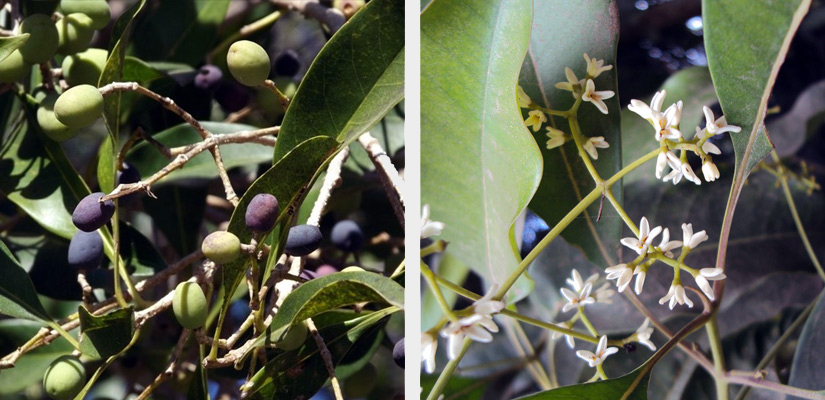
Chionanthus ramiflora fruit; and Flower By Vinayaraj – Own work, CC BY-SA 3.0
-
Mock olives – Notelaea spp.
The mock olives (Notelaea spp.) have oppositely arranged leaves with hairy (i.e. pubescent) or hairless (i.e. glabrous) undersides. Their flowers are borne in unbranched clusters (i.e. racemes) and their fleshy fruit are relatively small (5-20 mm long).
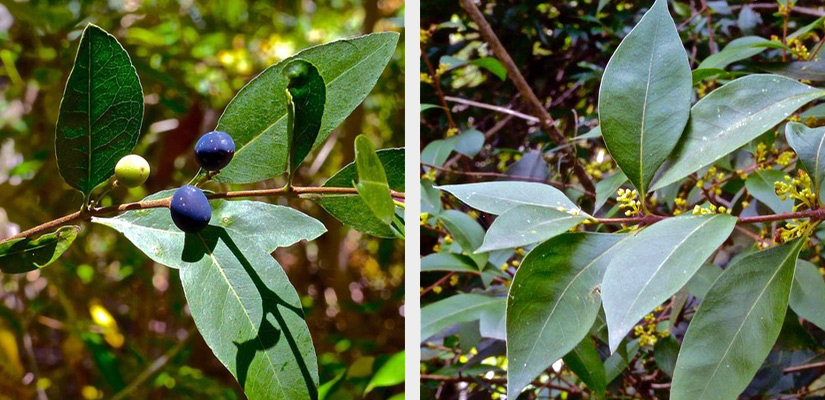
Notolaea Longiolia
